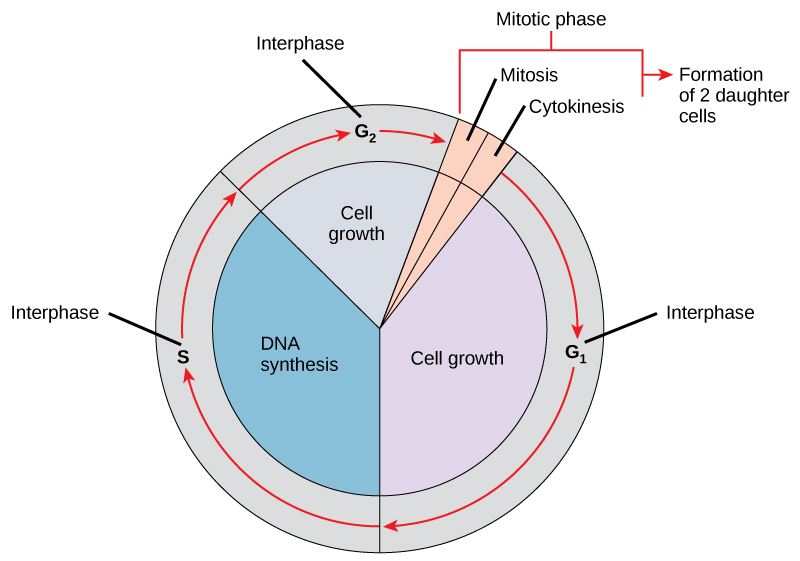Eukaryotic Cell Cycle
Introduction
The life cycle of the eukaryotic cell is called the cell cycle. In the simplest terms, the cell cycle consists of two major stages:

- Interphase
- Occurs between two successive cell divisions.
- Represents the largest portion of the cell cycle
- Mitotic Cell Division
- Easily distinguished under the microscope.
- The parent cell splits into two resulting (sometimes called daughter) cells.
- As we shall see, this division stage has two parts: mitosis and cytokinesis.
Learning
Let us now examine each of the different stages which occur during the life cycle of a typical eukaryotic cell.
Interphase
Let us first begin with Interphase (blue). It was once thought that the relatively long period of interphase was uneventful for the cell. Today we know that interphase is an active stage during which the cell prepares itself for division.
Interphase consists of three major stages: G1, S, and G2.
- G1 Stage – (G for “gap”)
- Occurs after division but before S phase begins.
- Period of growth during which both the size of the cell and its protein content increase.
- During G1 phase, particular proteins required for S phase are produced.
- S Stage – (S for “synthesis”)
- Entire DNA content of the nucleus is replicated.
- Each chromosome is ‘copied.’
- G2 Stage
- Occurs after S phase and before the start of division.
- Another set of proteins necessary for the cell to physically divide are produced.
- Additional physical changes to the nucleus occur to facilitate the equal distribution of DNA to the two resulting cells.
Mitotic Cell Division
The culmination of the cell cycle occurs during Mitotic Cell Division, which consists of two phases:
- Mitosis (orange area)
- During mitosis, the two copies of each chromosome are split/segregated.
- Cytokinesis (From the Greek terms cyto, “cell” and kinesis, “movement”; green area)
- Features the physical division of the parent cell into two progeny cells.

In animal cells, the physical act of separation is performed by a ring of proteins which form a belt at the equator of the cell. When this ring contracts, it “pinches” the cytoplasm of the cell and divides it in two.

In plant cells, it’s a little more complicated because they have a cell wall. In this case, a new cell wall begins forming during mitosis, physically dividing the cell into two independent daughter cells. Vesicles containing the cell wall components fuse together at the center of the dividing cell forming the cell plate.
Summary
In this module, we have explored the eukaryotic cell cycle and defined the key stages which occur, including:
- Interphase
- G1 – 1st Growth Phase
- S – Synthesis Phase
- G2 – 2nd Growth Phase
- Mitosis
- Separation of chromosome copies
- Cytokinesis
- Splitting of the cell into two daughter cells

Sources:
“Cell Cycle.” By OpenStax Biology 2e. Retrieved from https://openstax.org/books/biology-2e/pages/10-2-the-cell-cycle/ Licensed under: CC-BY: Attribution
The Role of the Cell Cycle. (2020, August 15). Retrieved May 20, 2021, from https://bio.libretexts.org/@go/page/13231
